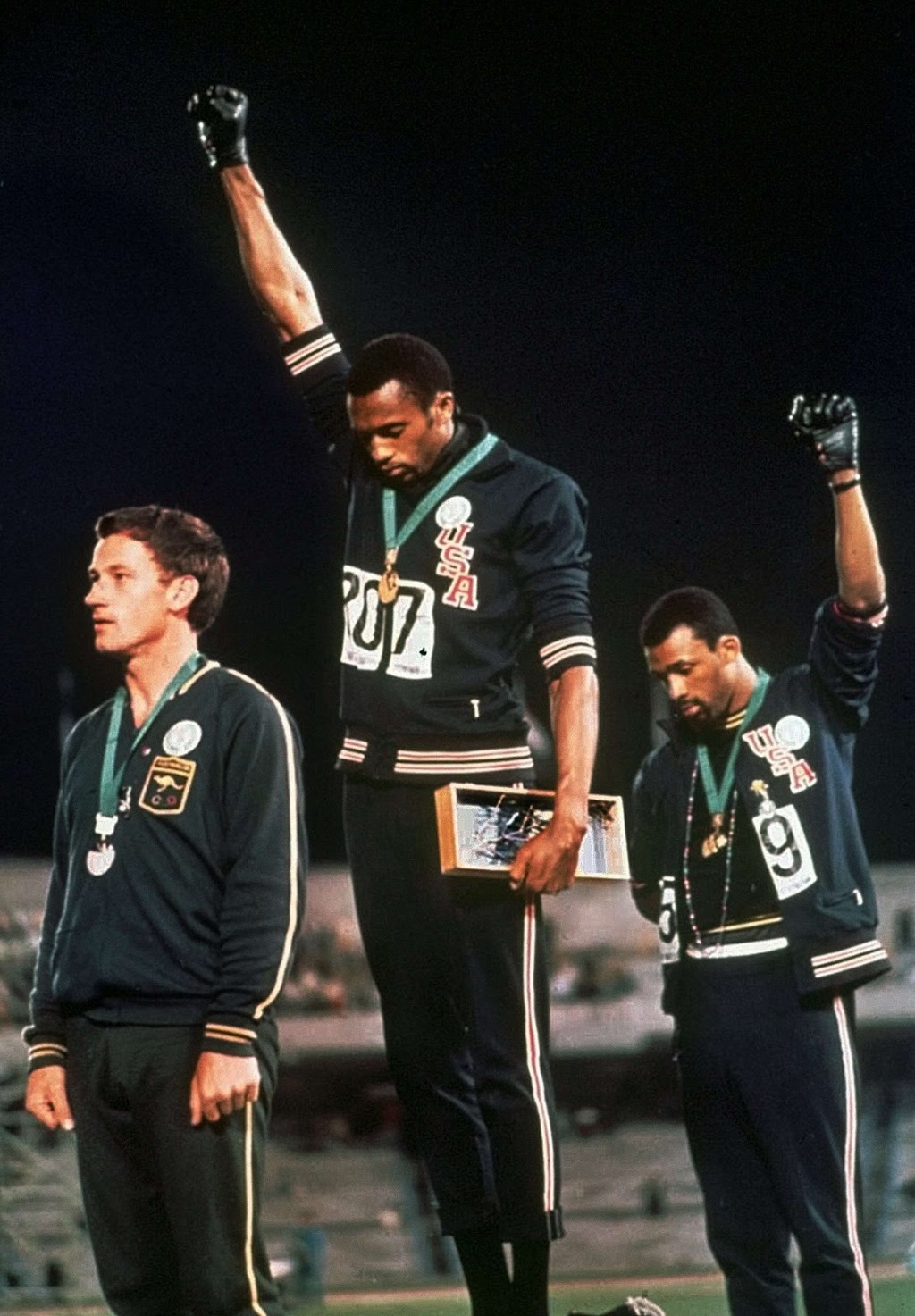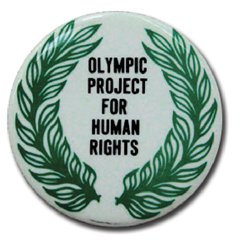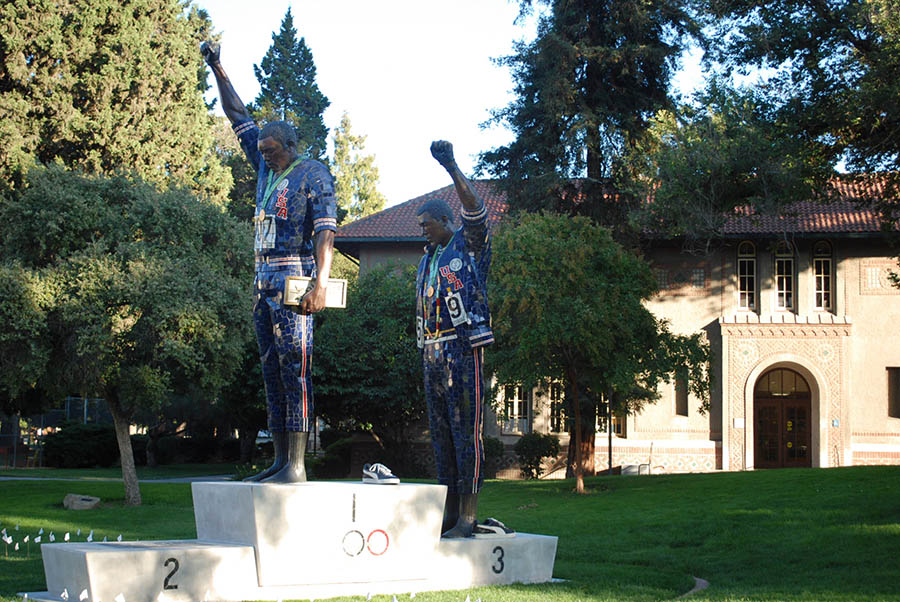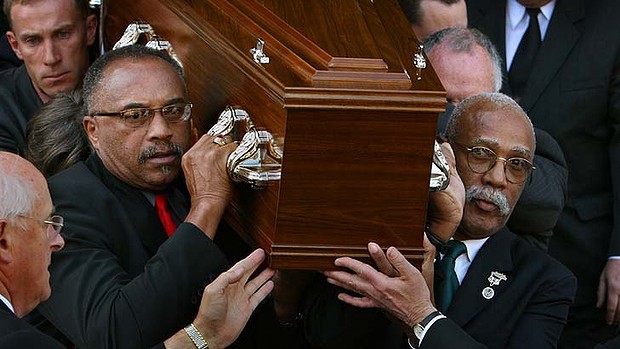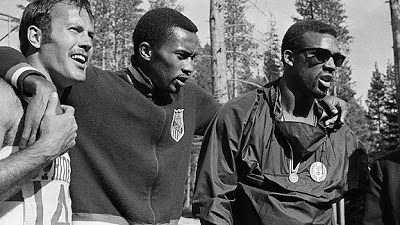The White Man in That Photo
ANGLO AMERICA, SPORTS, HISTORY, 2 Oct 2017
Riccardo Gazzaniga - GRIOT Magazine
3 Oct 2017 – Today marks the 11th anniversary of Peter Norman’s passing. We want to commemorate him by publishing this text written by Italian writer Riccardo Gazzaniga, who allowed us to share the story of the Australian sprinter.
Sometimes photographs deceive. Take this one, for example. It represents John Carlos and Tommie Smith’s rebellious gesture the day they won medals for the 200 meters at the 1968 Summer Olympics in Mexico City, and it certainly deceived me for a long time.
I always saw the photo as a powerful image of two barefoot black men, with their heads bowed, their black-gloved fists in the air while the US National Anthem, “The Star-Spangled Banner,” played. It was a strong symbolic gesture – taking a stand for African American civil rights in a year of tragedies that included the death of Martin Luther King and Bobby Kennedy.
It’s a historic photo of two men of color. For this reason I never really paid attention to the other man, white, like me, motionless on the second step of the medal podium. I considered him a random presence, an extra in Carlos and Smith’s moment, or a kind of intruder. Actually, I even thought that that guy – who seemed to be just a simpering Englishman – represented, in his icy immobility, the will to resist the change that Smith and Carlos were invoking in their silent protest. But I was wrong.
Thanks to an old article by Gianni Mura, today I discovered the truth: that white man in the photo is, perhaps, the biggest hero of that night in 1968. His name was Peter Norman, he was an Australian who arrived in the 200 meters finals after having ran an amazing 20.22 in the semi finals. Only the two Americans, Tommie “The Jet” Smith and John Carlos had done better: 20.14 and 20.12, respectively.
It seemed as if the victory would be decided between the two Americans. Norman was an unknown sprinter, who seemed to just be having a good couple of heats. John Carlos, years later, said that he was asked what happened to the small white guy – standing at 5’6”tall, and running as fast as him and Smith, both taller than 6’2”.
The time for the finals arrives, and the outsider Peter Norman runs the race of a lifetime, improving on his time yet again. He finishes the race at 20.06, his best performance ever, an Australian record that still stands today, 47 years later.
But that record wasn’t enough, because Tommie Smith was really “The Jet,” and he responded to Norman’s Australian record with a world record. In short, it was a great race.
httpv://www.youtube.com/watch?v=–lzACn0aZ8
Yet that race will never be as memorable as what followed at the awards ceremony.
It didn’t take long after the race to realize that something big, unprecedented, was about to take place on the medal podium. Smith and Carlos decided they wanted to show the entire world what their fight for human rights looked like, and word spread among the athletes.
Norman was a white man from Australia, a country that had strict apartheid laws, almost as strict as South Africa. There was tension and protests in the streets of Australia following heavy restrictions on non-white immigration and discriminatory laws against aboriginal people, some of which consisted of forced adoptions of native children to white families.
The two Americans had asked Norman if he believed in human rights. Norman said he did. They asked him if he believed in God, and he, who had been in the Salvation Army, said he believed strongly in God. “We knew that what we were going to do was far greater than any athletic feat, and he said “I’ll stand with you” – remembers John Carlos – “I expected to see fear in Norman’s eyes, but instead we saw love.”
Smith and Carlos had decided to get up on the stadium wearing the Olympic Project for Human Rights badge, a movement of athletes in support of the battle for equality.
They would receive their medals barefoot, representing the poverty facing people of color. They would wear the famous black gloves, a symbol of the Black Panthers’ cause. But before going up on the podium they realized they only had one pair of black gloves. “Take one each”, Norman suggested. Smith and Carlos took his advice.
But then Norman did something else. “I believe in what you believe. Do you have another one of those for me”? he asked, pointing to the Olympic Project for Human Rights badge on the others’ chests. “That way I can show my support for your cause.” Smith admitted to being astonished, ruminating: “Who is this white Australian guy? He won his silver medal, can’t he just take it and that be enough!”.
Smith responded that he didn’t, also because he would not be denied his badge. There happened to be a white American rower with them, Paul Hoffman, an activist with the Olympic Project for Human Rights. After hearing everything he thought “if a white Australian is going to ask me for an Olympic Project for Human Rights badge, then by God he would have one!” Hoffman didn’t hesitate: “I gave him the only one I had: mine”.
The three went out on the field and got up on the podium: the rest is history, preserved in the power of the photo. “I couldn’t see what was happening,” Norman recounts, “[but] I had known they had gone through with their plans when a voice in the crowd sang the American anthem but then faded to nothing. The stadium went quiet.”
httpv://www.youtube.com/watch?v=0biCuBy4yVg
The head of the American delegation vowed that these athletes would pay the price their entire lives for that gesture, a gesture he thought had nothing to do with the sport. Smith and Carlos were immediately suspended from the American Olympic team and expelled from the Olympic Village, while the rower Hoffman was accused of conspiracy.
Once home the two fastest men in the world faced heavy repercussions and death threats.
But time, in the end, proved that they had been right and they became champions in the fight for human rights. With their image restored they collaborated with the American team of Athletics, and a statue of them was erected at the San Jose State University. Peter Norman is absent from this statue. His absence from the podium step seems an epitaph of a hero that no one ever noticed. A forgotten athlete, deleted from history, even in Australia, his own country.
Four years later at the 1972 Summer Olympics that took place in Munich, Germany, Norman wasn’t part of the Australian sprinters team, despite having run qualifying times for the 200 meters thirteen times and the 100 meters five times.
Norman left competitive athletics behind after this disappointment, continuing to run at the amateur level.
Back in the change-resisting, whitewashed Australia he was treated like an outsider, his family outcast, and work impossible to find. For a time he worked as a gym teacher, continuing to struggle against inequalities as a trade unionist and occasionally working in a butcher shop. An injury caused Norman to contract gangrene which led to issues with depression and alcoholism.
As John Carlos said, “If we were getting beat up, Peter was facing an entire country and suffering alone.” For years Norman had only one chance to save himself: he was invited to condemn his co-athletes, John Carlos and Tommie Smith’s gesture in exchange for a pardon from the system that ostracized him.
A pardon that would have allowed him to find a stable job through the Australian Olympic Committee and be part of the organization of the 2000 Sydney Olympic Games. Norman never gave in and never condemned the choice of the two Americans.
He was the greatest Australian sprinter in history and the holder of the 200 meter record, yet he wasn’t even invited to the Olympics in Sydney. It was the American Olympic Committee, that once they learned of this news asked him to join their group and invited him to Olympic champion Michael Johnson’s birthday party, for whom Peter Norman was a role model and a hero.
Norman died suddenly from a heart attack in 2006, without his country ever having apologized for their treatment of him. At his funeral Tommie Smith and John Carlos, Norman’s friends since that moment in 1968, were his pallbearers, sending him off as a hero.
“Peter was a lone soldier. He consciously chose to be a sacrificial lamb in the name of human rights. There’s no one more than him that Australia should honor, recognize and appreciate” John Carlos said.
“He paid the price with his choice,” explained Tommie Smith, “It wasn’t just a simple gesture to help us, it was HIS fight. He was a white man, a white Australian man among two men of color, standing up in the moment of victory, all in the name of the same thing”.
Only in 2012 did the Australian Parliament approve a motion to formally apologize to Peter Norman and rewrite him into history with this statement:
This House “recognises the extraordinary athletic achievements of the late Peter Norman, who won the silver medal in the 200 meters sprint running event at the 1968 Mexico City Olympics, in a time of 20.06 seconds, which still stands as the Australian record”.
“Acknowledges the bravery of Peter Norman in donning an Olympic Project for Human Rights badge on the podium, in solidarity with African-American athletes Tommie Smith and John Carlos, who gave the ‘black power’ salute”.
“Apologises to Peter Norman for the wrong done by Australia in failing to send him to the 1972 Munich Olympics, despite repeatedly qualifying; and belatedly recognises the powerful role that Peter Norman played in furthering racial equality”.
However, perhaps, the words that remind us best of Peter Norman are simply his own words when describing the reasons for his gesture, in the documentary film “Salute,” written, directed and produced by his nephew Matt.
“I couldn’t see why a black man couldn’t drink the same water from a water fountain, take the same bus or go to the same school as a white man.
There was a social injustice that I couldn’t do anything about from where I was, but I certainly hated it.
It has been said that sharing my silver medal with that incident on the victory dais detracted from my performance.
On the contrary.
I have to confess, I was rather proud to be part of it”.
When even today it seems the fight for human rights and equality is never-ending, and innocent lives are being taken, we have to remember the people that have already made self-sacrifices, like Peter Norman, and try to emulate their example. Equality and justice is not a single community’s fight, it’s everyone’s.
So this October, when I’ll be in San Jose, I am going to visit the Olympic Black Power statue on the San Jose State University campus, and that empty podium step will remind me of a forgotten, but truly courageous hero, Peter Norman.
************************
The Writer in that post | Message by Riccardo Gazzaniga –added on 13 Oct 2015
“I have one rule, when I publish a piece in some magazine: let it go, don’t answer to the comments: everyone can have his own idea about what I wrote.
But my article about Peter Norman had an enormous, incredible number of sharings worldwide: 300.000 on Facebook, over 5.000 tweet about it; so I think it’s right for me to leave just one single, public comment to clearly explain some things for which some readers criticized me”.
Some of them said I’m trying to “whitewash” the story. No, they’re wrong, this wasn’t absolutely my intention. When I say that FOR ME Peter Norman is the hero of this story, I’m not looking at the color of his skin: he could be white, black, yellow or a man from the moon; it’s not the real matter.
I’m not a historical researcher, I’m not an activist, I’m not a journalist. I’m just a writer (or this is what I’m tryin’ to be) and I decided to tell this story to my readers. My piece is not about who was “more hero” or about which country was good or bad or better.
My piece, all of this story, it’s about men and choices. Norman found himself in this historical moment and in just few seconds he made a choice and he had the strength to repeat the same choice all through the years, even if he was silently suffering alone and he could retreat to save himself.
If you listen to Carlos and Smith public speeches I think you can clearly understand that the real struggle started after that race and that night. And you can listen how grateful they are to this man. Tommie Smith and John Carlos made an enormous thing, they changed the story and finally the whole world recognized their role.
Norman decided in just one moment, and his decision changed and, in some way, destroyed his life. The most impressive thing in this story, for me as a man and as a writer, it’s not about that single night but about the silent strength he had to never make one step down. This is not a competition between Smith, Carlos and Norman. They ran one against other only in that night of 1968, after they always ran together.
This story is so powerful and has been so shared not because I’m so good as a writer, but because it deeply touches a lot of hearts. Because is a story of sport and courage, friendship and loyalty. It’s a story about the strength of being human.
And all of these things, they have no colour.
The second thing:
Some people from England wrote me, angry because a used the expression “simpering Englishmen”.
Yes, I used it. I used to explain another kind of stereotype, a stupid simplification even I was doing, when I was younger and I looked at that photo, keepin’ my eyes to those beautiful, strong black men and don’t lookin’ at the white man, like he didn’t exist.
My eyes, like the eyes of all the world, they were all taken by those fist up in the air and I didn’t even notice the color of the uniform, green, instead of the white English uniform. My expression tried to explain how wrong we all can be just takin’ a look at a photo and judge without think.
I think in Italian version my ironic tone was more clear and I’m sorry if someone couldn’t understand it and felt hurt.
The last thing:
I received a lot of thankful and lovely messages through mail and social network from all over the world. I also received some offences, that was predictable.
Yesterday a young man wrote me this racist message: “Go fuck yourself, dago piece of shit”. I think it clearly explains how still long is this road.
“History doesn’t repeat itself. But it does rhyme” (Mark Twain).
Sorry for my bad English and best regards to all of you.
Riccardo
_______________________________
Original text by Italian writer Riccardo Gazzaniga.
Translation and comment by Alexa Combs Dieffenbach.
Read it on Riccardo Gazzaniga’s website
DISCLAIMER: The statements, views and opinions expressed in pieces republished here are solely those of the authors and do not necessarily represent those of TMS. In accordance with title 17 U.S.C. section 107, this material is distributed without profit to those who have expressed a prior interest in receiving the included information for research and educational purposes. TMS has no affiliation whatsoever with the originator of this article nor is TMS endorsed or sponsored by the originator. “GO TO ORIGINAL” links are provided as a convenience to our readers and allow for verification of authenticity. However, as originating pages are often updated by their originating host sites, the versions posted may not match the versions our readers view when clicking the “GO TO ORIGINAL” links. This site contains copyrighted material the use of which has not always been specifically authorized by the copyright owner. We are making such material available in our efforts to advance understanding of environmental, political, human rights, economic, democracy, scientific, and social justice issues, etc. We believe this constitutes a ‘fair use’ of any such copyrighted material as provided for in section 107 of the US Copyright Law. In accordance with Title 17 U.S.C. Section 107, the material on this site is distributed without profit to those who have expressed a prior interest in receiving the included information for research and educational purposes. For more information go to: http://www.law.cornell.edu/uscode/17/107.shtml. If you wish to use copyrighted material from this site for purposes of your own that go beyond ‘fair use’, you must obtain permission from the copyright owner.
Read more
Click here to go to the current weekly digest or pick another article:
ANGLO AMERICA:
SPORTS:
- Chess Prodigy at Three: He’s Internationally Ranked but Is Confused and Scared by the Limelight
- The Drama and Suffering of the World Chess Championship
- Chess King Gukesh: How an 18-Year-Old Indian Dreamer Checkmated the World
HISTORY:
